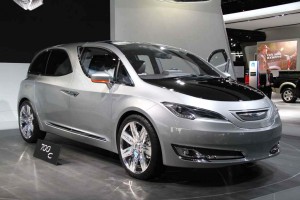
Chrysler tested the waters for a more radical minivan alternative with the 700C concept unveiled at last year's Detroit Auto Show.
Chrysler is testing the waters to see which of four minivan concepts will best resonate with consumers – a critical challenge if the maker hopes to retain its lead in a segment it invented 30 years ago but which has come under increasing assault from foreign-owned brands like Toyota and Honda.
The Detroit maker has seen its lead steadily erode in recent years and has been forced to sharply reduce production capacity and the number of individual minivan models it offers. Likely only one will survive the shoot-out in the design competition, according to a report by the Detroit Free Press.
“We know not all of them will see the light of day, but we spend a lot of time studying scenarios, trying out designs that could work in each scenario so we’re ready whichever way it goes,” said Ralph Gilles, Chrysler’s design director.
Though there had been minivans on the market before – notably the fabled Volkswagen Microbus – Chrysler took the concept mainstream in 1984 with the Dodge Caravan and Plymouth Voyager models. It would soon add long and short-wheelbase variants, and nudge the concept a bit up-market with the Chrysler Town & Country. And after the maker’s effective takeover by Fiat, it began marketing a European version as the Lancia Voyager.
(Yet another version is sold through Volkswagen as the Routan.)
But the heyday of the minivan has long passed and demand is barely half what it once was, falling from a 2000 calendar-year peak of 1.7 million – a whopping 7.2% of the U.S. new vehicle market — to just 472,398 in 2011. Chrysler closed its St. Louis plant but hopes to continue running a second facility, in Windsor, Ontario.
The challenge is to come up with a product that can reconnect with buyers who have largely dismissed the minivan as an unloved “mom-mobile,” opting instead for less flexible but more stylish SUVs and crossovers.
In fact, of the four prototypes Chrysler is studying only two are true minivans, Gilles revealed, the other two better fitting into the crossover-utility vehicle, or CUV, category. The Dodge and the Chrysler brands have one of each they are trying out in a series of consumer clinics.
There are some positive signs for the minivan market, as a whole, sales surging to 532,000 during the first 11 months of this year – growing even faster than the overall 15% upturn in the American automotive market.
But that doesn’t mean Chrysler can relax. Quite the contrary, it seems. It has been trying to come up with a prototype design that might truly resuscitate the minivan segment for some years, a process underscored with the unveiling of the extreme Chrysler 700C concept at last year’s Detroit Auto Show.
Officials aren’t saying whether any of that prototype has been incorporated in the new model, nor are they revealing much else.
Chrysler officials have indicated they plan to pull one of the existing minivan models out of production. That reflects Fiat/Chrysler CEO Sergio Marchionne’s desire to quit badge-engineering — the marketing of essentially identical products under two different brand names. It is possible, of course, that feedback from those consumer clinics could be positive enough to have the maker decide in favor of more than one model.
But it’s running out of time to make a move. The current line-up, the maker’s fifth generation of minivans, debuted in 2007 as a 2008 model. Considering both Toyota and Honda have updated their offerings since then – and with Ford hoping to re-enter the segment with the distinctively designed new Transit Connect Wagon – Chrysler has to bring something new to market within the next two to three years or risk having its current products seem outdated.
